Tim Cooke
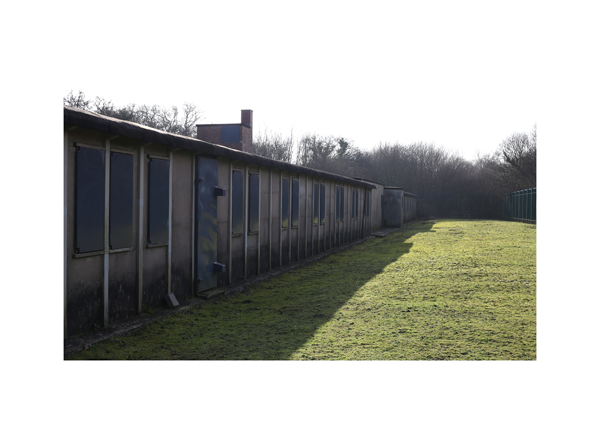
I was fourteen when I first visited the war camp at Island Farm, which is strange because my parents’ house is less than half a mile from the site. As far back as I can recall, my friends and I would roam freely through the polymorphic landscapes surrounding the huts, but we were firmly warned to keep away from the zone itself, overgrown and overlooked. Stranger still is the fact that none of my primary or secondary school teachers ever took the initiative to organise a trip to this place of extraordinary local significance. The previous summer, I’d travelled by bus to Belgium with my history class, to see the battlefields at Flanders, but somehow I’d not managed to get across the perilous A48.
Why the zone was quite so off limits is still a mystery to me. But I do have vague memories of weird stories concerning wild and dangerous men, rogue youths and illegal motorbike races, and even dead bodies, but I suspect these to be mostly cases of confabulation. One of the stories in particular remains clear in my mind: that of a satanic ritual carried out by a tribe of juvenile Goths, pre-Marilyn Manson disciples of darkness driven by a cocktail of boredom, adolescent angst and that unrefined suburban creativity – provincial and so often ferocious. One morning in winter, a dog walker came upon a tree hung with slaughtered rabbits, like dream-catchers dangling in the wind, but for the eerie absence of sound.
It was a hot afternoon in summer when two schoolmates and I took our bikes across the busy A-road that separates the camp from the town’s southern-most suburb. One of the boys had been there the week before with an older lad he knew, and he spoke now of ramps constructed from discarded domestic appliances, slabs of stolen turf and youthful ingenuity. The pull was too strong to resist. We set off with a confidence endowed by a packet of stolen cigarettes and our front-fork suspension, ready for anything – pastures new and prohibited.
I can’t seem to retrieve the journey there, apart from the final stretch. We dismounted and pushed our bikes along a thin dirt track almost subsumed in knots of bracken and bramble, when suddenly, beyond a threshold of lush foliage, a series of makeshift obstacles emerged. There were ten or 20 teenage boys and girls; some were sat in groups around an earthy dome, smoking and drinking, while others were tackling the circuit on mountain bikes and BMXs. The air was thick with dust ripped from the ground, a pollenous miasma – uncanny, hormonal and stiflingly exciting. We approached with caution, turning a few hostile heads, but the atmosphere was generally one of welcome.
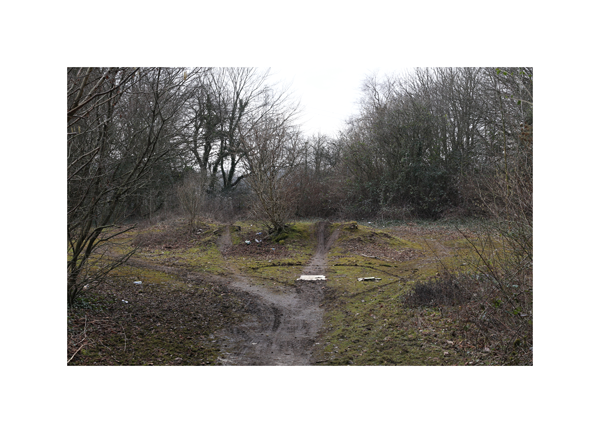
That first visit – and the countless more that followed over the years – remains as a kind of montage, or mosaic. I remember my apprehension when confronted by the prospect of an almost sheer ramp comprised of a derelict washing machine, a bundle of tangled sticks and branches, and a thick layer of turf. I lacked the necessary pace in my approach and toppled painfully from the summit, a combination of pedal and frame stabbing into my shin and groin on impact. I did my best to hide my tears. There was a girl, too, with faint freckles and braces on her teeth.
Later, I would spend a night in a tent beneath the cover of trees, guzzling cheap cider by the flagon and finding my place within the hierarchy of a new social group. I also recall a kiss amid smoky shadow and walls of cool stone, but this might be another case of creative remembering. The most recent event I recollect, however, comes with a rare degree of clarity: I was on the passenger side of an antediluvian Metro, cruising along the dual carriageway, when the driver, feral and intoxicating, took a sharp right and bundled into the pitch-dark zone. He dragged the car in loops around an unofficial rally track, illuminated only by headlights, in the company of kindred spirits – vivid, yes, but dreamlike and unreal, too.
*
The huts at Island Farm were originally built to house employees travelling from afar to work at the nearby munitions factory, which was, at the time, the largest in Europe. This mammoth, town-sized complex was split into two sections: the first where the shells were made and the second a network of underground tunnels used for storing the primed explosives. The 8Xs, as the tunnels are now known, form another potent landscape within the district. Buried beneath the wooded flank of a large housing estate, they provide both solace and danger for the town’s young population, a mythical terrain for the disillusioned – or simply bored and energetic – to claim for themselves. It’s a Billy-Casper landscape, where town leaks into countryside and dark fairy tales are born.
It’s astonishing to note that the factory, photographed from above by a Luftwaffe pilot on reconnaissance in 1940, survived the war. Locals have tried to put it down to a curious, eldritch mist that hangs over the region in the morning and then descends again in the evening. Whether or not this can explain the Germans’ surprising inaccuracy is unclear, but something otherworldly does seem to have intervened. Bombs hit the nearby villages of Ewenny, Coity, Laleston, Litchard, Treoes and Merthyr Mawr, leaving craters, too, in the vast expanse of sand dunes that stretch away to the coast, but the arsenal remained intact and functional.
Despite what was, for many, a long and arduous commute, the factory’s workforce of 40,000 – ferried in and out by a fleet of 144 buses and ten railway trains – was reluctant to make use of the barracks at Island Farm, preferring instead to return home each evening. This was a mutant workforce, discernable by their yellow skin, green hair and yellow teeth – a species altered by the bright dye added to illuminate the cordite explosive. They wandered the streets in cape-like gowns, turbans and rubber shoes, like comic book characters, radioactive and revolutionary. There are terrible tales of men and women blown to pieces on the job, doing their duty.
With its failure to fulfil its role as digs for these metamorphosing workers – usually women aged between their late teens and early 20s – Island Farm would later be used as accommodation by a U.S. Army division awaiting dispatch for the D-Day landings. President Eisenhower is even reported to have paid a visit, delivering a stirring address from the back of a jeep to a crowd of cheering soldiers. Then, in 1944, the site was repurposed as a POW camp, under the moniker Hut 198, complete with high-security fences. It would soon be home to some 2,000 prisoners, but was deemed too comfortable for enlisted men; and so, on a cold day in November, a freight of high-ranking officers arrived, marching through muddy puddles, crying “Deutschland Uber Alles”.
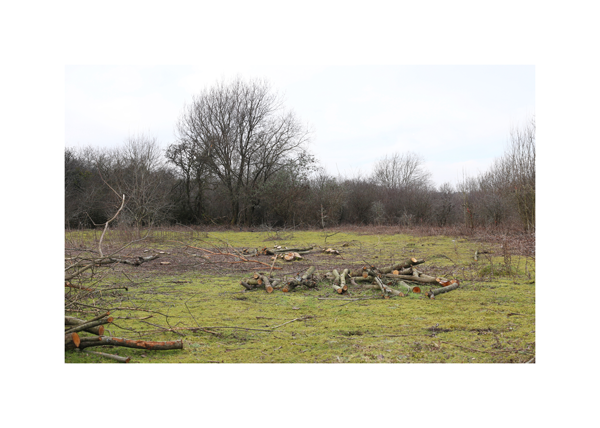
The most famous incident recorded in the site’s official history occurred on the morning of 11 March 1945, when 70 prisoners escaped through an underground tunnel – almost three metres deep – that ran from Hut 9 into an adjacent field. The round up that followed was successful, if farcical. All 70 men were recaptured, but not before an armed guard had disappeared down the mouth of the tunnel’s exit hole, to the amusement of the watching fugitives. There are also reports of a local resident walking home from a boozy night at the pub and urinating on two escapees hiding amid shrubbery; and of a mysterious Canadian soldier mistakenly shooting his lover in the stomach whilst defending her from two attacking Nazis – this was proved, in part, a fabrication.
Some of the escaped men got as far as Birmingham and Southampton, but I like to imagine those figures lurking in the shadows beneath the beech trees I’d climb 50 years later, in my parents’ front garden.
In November 1945, Hut 198 became Special Camp 11, hosting a roll call of the German military elite, including Generalfeldmarshall Gerd von Rundstedt, who oversaw the implementation of Blitzkrieg. The war ended and prisoners remained at the farm for another three years, for various reasons: some awaiting trial, others to give evidence at trials and many anticipating extradition transfers. Over the 69 years since its closure, the camp and its surrounding area has slipped in and out of obscurity, taking on a myriad of identities, lingering in the town’s subconscious as a ghostly trace of the horrors of conflict.
In 1993, all of the prefabricated concrete structures, except for Hut 9 – home now to a colony of protected bats – were demolished. A project was undertaken, though, to preserve artwork scrawled by the prisoners, like cave paintings, on the walls of the huts. These haunting compositions are mainly of women, longingly retrieved from the vaults of desperate memories and scratched into stone. There’s Cora, Monika, Ann, Ulla, Erika, the Scantily Clad Lady, A Lady Reclining, Lady Exiting Swimming Pool and, simply, A Woman. Plans to display the artwork at a cost of £100,000 drew harsh criticism from a controversial council leader, who described the exhibition as a “shrine to Nazism”.
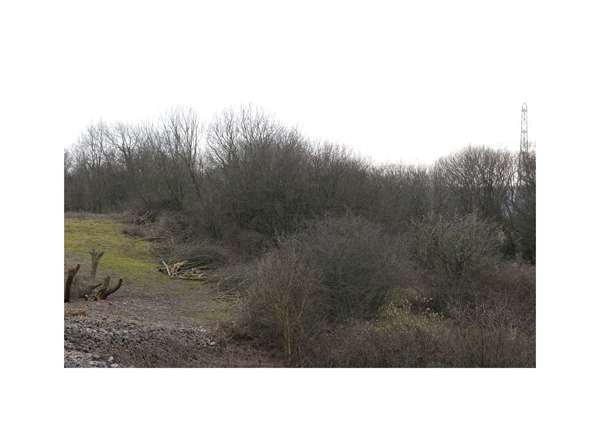
Despite attempts to turn the site into a car park, a business park and countless other short-termist fancies, Island Farm has remained as a strange sort of edgeland – a liminal strip of what Victor Hugo would have called the “bastard countryside”, a marginal territory that has, for as long as I can remember, felt up for grabs. What’s strange is that it’s both written and unwritten. There’s a clear, accepted history – known at least to enthusiasts and those who live in the surrounding area – that’s bound up in the one remaining hut, and then there are the oblique personal histories and mythologies – local, complex and largely unobtainable, but somehow permitted. How often do places of such special historic interest generate such little public attention? And how often are they given over, if inadvertently, to ordinary people and inglorious nature?
Occasionally, of course, the histories will collide: in the mid-1980s, a group of “vandals” kicked through a false wall in Hut 9 – constructed by the POWs – to reveal an enormous store of clay balls made by the tunnelling prisoners, who, when captured, refused to divulge how they’d disposed of the excavated soil. Who were these archaeologically inclined “vandals”? It gave me great pleasure to learn, too, that the ground on which we once rode our bikes is covered with a layer of rubble taken from the 19 destroyed units. The debris was supposed to help extend a runway at Cardiff Airport, but was scattered instead to level the uneven ground. Grass has since grown over it.
*
In his introduction to Little Toller’s reissue of Richard Mabey’s classic The Unofficial Countryside, Iain Sinclair – whose parents lived not ten minutes’ walk from Island Farm – draws attention to Mabey’s thoughts on how the rambler learns “to look at sewage farms and airfields… as if they were natural landforms, inexorably tied to local history and geology”. I am learning – rightly or wrongly – to do the same. Today, my partner, our ten-month-old daughter and I are walking from my mum and dad’s house, which we are visiting from our home in East London, to the abandoned camp. It will be the first time I have set foot on the terrain in over 13 years.
We decide to detour and so exit the back garden through a gate onto the town’s largest arrangement of amateur playing fields. We head straight for the river at the far end and follow its course towards the A48, where an oddly urban-looking subway burrows beneath the road and emerges onto a path that runs beside farmland. The tunnel transports me into the past, stirring long lost memories into a fizzing swirl of fact and fiction – indecipherable and beyond language. Scribbled on the white walls are lines upon lines of self-conscious rage and puerile humour: Satan wins; kick to kill; Jonesy was yer but not for long; moden man, a moden monkey… just another happy junky.
Once on the other side, we admire a graffitied image of an ancient pyramid surrounded by saplings curling into its base, before turning around and walking back through to the present. We skirt the touchline of a club rugby pitch, exit the boundary of the fields and re-join the A48 at the edge of a moderately busy junction. Two cars race by and we cross, approaching an inlet in the road from which we will infiltrate the site. There’s a no-entry sign, an almost sure-fire way to identify a landscape worth entering.
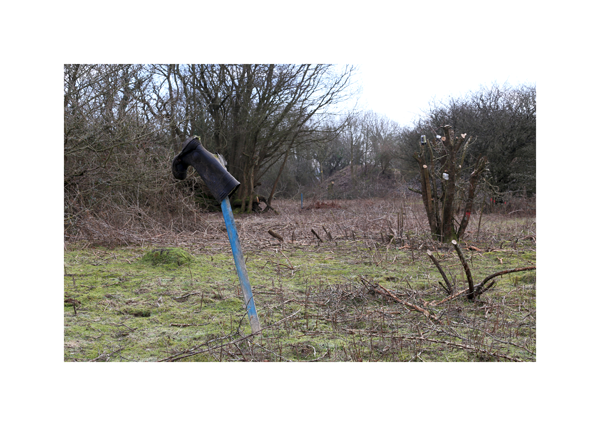
We follow a narrow track deep into a maze of thicket, the groan of traffic clear but growing fainter as we go, accompanied by vague bursts of birdsong. The ground is heavy underfoot. Soon enough, the corridor opens out onto a wide and unusual expanse of grey land. There are sprays of bulbous bramble, coppiced trees and traces of human life everywhere. Two wellington boots on blue stumps serve as markers for something I can’t ascertain. Beer cans, paint and plastic glasses adorn branches, and there’s a strange smell in the air. Stacks of fallen wood pepper the ground; something is happening.
We hear voices and barking. Two men, one tall and gawky, the other tall and broad, stroll into view, the first yelling at a whippet and the second tossing a ball for a dog the size of a bear. The beast bounds towards us and I step, trembling, between its line and our baby. The young Caucasian shepherd hurtles into my midriff, raises its head and licks my face. “Don’t mind him,” the stranger calls, striding for us, “he’ll not bite.” His accent is from the Black Country. He’s wearing a filthy denim cap and has a gold stud in his ear.
As I set up my tripod and begin to take photographs, the man asks if I’m local. I explain that I lived across the road until ten years ago, when I left for university and never really returned. His older companion asks if I’m a journalist, or am I just photographing the wildlife? A bit of both, I explain. Sensing he’s found a pair of receptive ears, he launches into a detailed, politically charged account of the spot’s recent history. He tells me of a businessman’s desire to turn the land into either housing or a fancy tennis club. He seems kind, knowledgeable and angry. He directs me to the top a pile of broken stone and brick for a better view. I thank him and we move on.
At the top of the slope, I survey the topography. To my left are the bare bones of a felled tree, arching monstrously in the direction of the sun. Straight ahead is a line, a ley boundary where open space slips neatly into woodland, the crossing point covered with a buffer of timber. To the right is a faintly purple assortment of winter canopies, voiceless and outside of time – monumental witnesses to all and nothing. Behind them, stretching into the horizon, is a pylon, symbolic with its silver trunk of smooth steel and electric-wire branches. I try my best to absorb and process this image, then snap a picture with my camera, knowing full well the limitations of the lens.
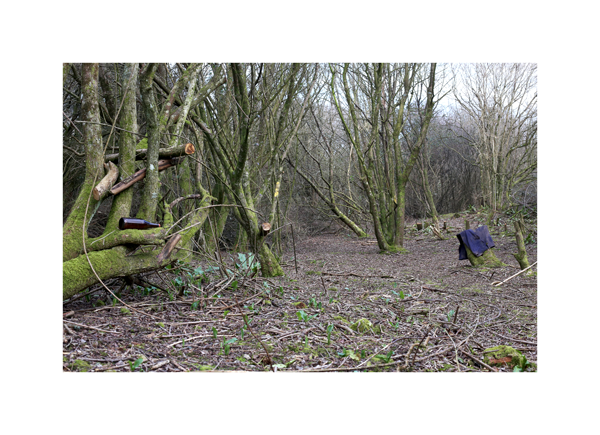
There’s a problem, a rewarding one: I can’t remember the way to Hut 9. We choose a path at random and re-enter the labyrinth. A savage alarm call, high pitched and aggressive like a chainsaw, ripples through the undergrowth. What creature is this? A memory quivers in the fog: the growl of a scrambler, two or three, in fact. We pass a colourful snarl of twigs and litter – juice cartons and empty packets of jelly babies – and come upon three lads in black and fluorescent leathers, revving their bikes at the centre of a series of brown jumps that rise and fall like a leviathan in the ocean.
“Do you mind if I take some shots?” I ask, feigning confidence – we’re coming full circle. “Not of us, yeah?” one replies. They seem reasonable enough, rough around the edges, of course, as you’d hope. “You know this spot?” they ask. I explain I used to hang out here, riding BMXs over broken washing machines. They smirk and light king-sized cigarettes. It’s a “pump track” now, they tell me, but no one really uses it anymore. They mount their bikes and skid once around the circuit, in exhibition, before evaporating like spectres. I hear them blast up the dual carriageway, towards the next town.
The man with the whippet re-appears and puts us back on track. We pass a still-life scene – a pair of blue trousers spread out on a tree stump, with an empty alcohol bottle resting in the crook of a nearby branch – and traipse along a gravel path, gulls crying overhead. A huge buzzard swoops from the foliage on the left into shrubbery on the right, not five metres ahead. It’s an extraordinary, primeval vision, as close as I’ve ever been to an unmanned bird of prey. Further along, we find a sculpture comprised of a rusted dustbin, a twist of metal frames and a scattering of strange objects: non-descript green wheels, a plastic turtle shell and sticks of various colours and sizes.
Finally, we can see Hut 9, surrounded by a set of imposing steel fences. I stoop low to take a photograph, when a man with matted hair, hunched and wild looking, stumbles from the shadows into the frame. He mutters an unnecessary apology and moseys on. We circumnavigate the long, unremarkable structure, which is suddenly bathed in golden-hour light, and peer through bars at boarded-up windows and weathered brickwork. Something that looks like a chimney stirs rootless feelings. Up close, this palimpsest landform does not feel unnatural, and there is no ratified signage; it’s not a museum.
We take a seat, with our backs to the green steel, and tuck into a late lunch of sandwiches, apples and chocolate. Time falters and evening rolls in, and with it a mist to obscure the way back home.
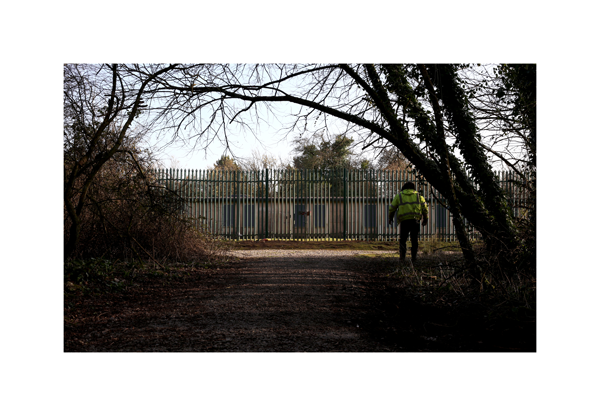
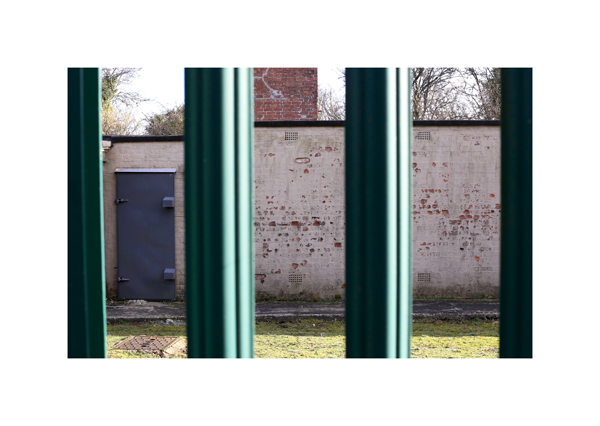

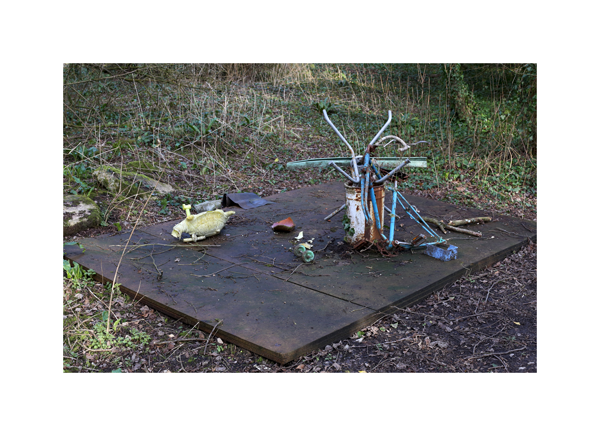
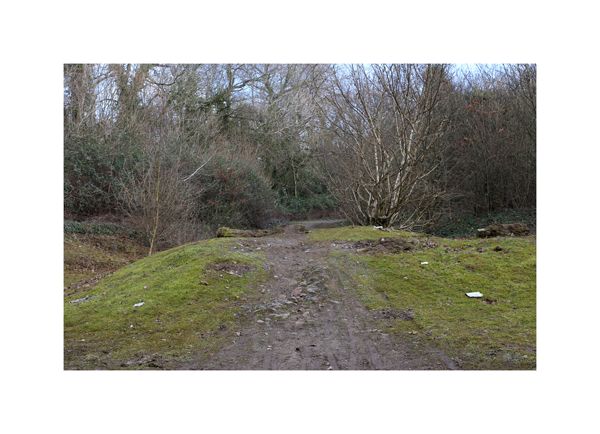
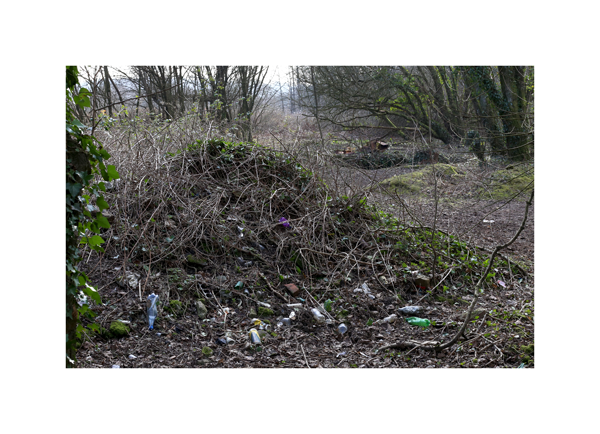
These reflections owe a debt of gratitude to the fascinating information collated at www.islandfarm.wales and in Peter Phillips’s book The German Great Escape. Since writing this piece, I have been delighted to learn, through faux-sepia photographs displayed on a busy Facebook page, that open days and historical re-enactments have recently been held at the camp – another haunting, tangential amalgamation of past and present.
Tim Cooke is a teacher and freelance journalist. He did a BA in English Literature and an MA in Digital Documentary, both at the University of Sussex. Tim writes about film and literature for various publications including the Guardian, Little White Lies, the Quietus, Ernest Journal, the Nightwatchman and the Hackney Citizen. His creative work has appeared in the Lampeter Review, Stepz, Particulations and Litro Magazine. Follow him on Twitter @cooketim2